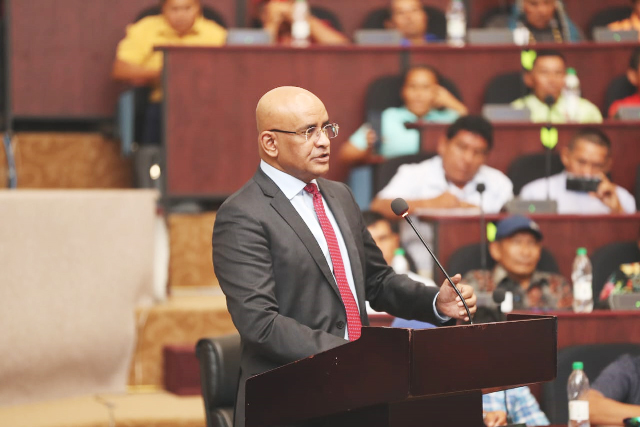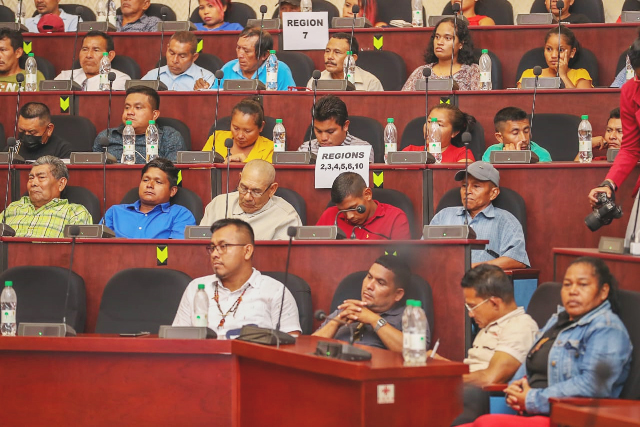Population size was a key determining factor in government’s methodology for the distribution of money earned from Guyana’s sale of carbon credits, Vice President Bharrat Jagdeo explained yesterday as he announced the first payment of $4.7 billion or US$22 million to 241 indigenous communities.
“Based on the application of the formula, based on population and size, you are going to see how much money the communities are getting, ranging from $10 million to some communities, their share of the 15 per cent this year, would be $35 million… we agreed that a minimum that a village or a community should get from this year, from their share is $10 million,” the Vice President said during a meeting with Indigenous leaders.

Government’s disbursement comes on the heels of some Indigenous communities calling for a greater percentage of monies. Activists in the Indigenous community have complained that there was little consultation on the process before arriving at the percentage to be given to Indigenous communities.
Lemuel Thomas, Toshao of Kamarang and leader within the Upper Mazaruni District Council, yesterday requested that the government increase the percentage to the communities and also direct funds towards the work of sub-regional district councils and other Indigenous people’s bodies lobbying for the rights of Amerindians.
The payments ranging from $10 million to $35 million will be disbursed to specially established bank accounts in the new week, Jagdeo announced. The amount disbursed represents 15 per cent of the US$75 million from the sale of certified carbon credits sold to Hess Corpo-ration. Jagdeo noted that the direct allocation is a part of the recognition of the Indigenous people and the stewardship roles they play in the protection of the forests, hinterland communities, and maintenance of the hinterland eco-systems.
During the meeting held at the Arthur Chung Con-ference Centre, Jagdeo explained that before arriving at the formula, government consulted with the National Toshaos Council (NTC) and with many others in the regional setting, as well as individually, to arrive at a fair formula.
Critics have argued strongly that the NTC is not the prescribed body and talks have to be held with individual councils
The Vice President was quick to point out that the sum is only from the sale of 30 per cent of the certified carbon credits and should government manage to sell more of the remaining credits this year, the communities will benefit from a higher sum.
“Of the US$700 million in the next 10 years, the Amerindian communities will be entitled to a US$112.5 million or $23.6 billion, which is what your share is of only 30 per cent. Remember when we sell more, if we sell the other 70 per cent, you are going to get 15 per cent of that too. So, it will run into a significant sum of money, over US$300 million you’ll be getting from that alone, if we get the same terms.”
Communities were requested to open specific accounts for the monies to be deposited so as to enable audits and make accountability easier.
While he stated that government will not direct the spending of the monies, he expressed the wish to see the funds directed to programmes which will translate into benefits for all citizens. He hinted that government will like to see the funds used to support empowerment projects in the social sector, for job creation, and/or on food security efforts.
Though the finances will be placed in the accounts next week, communities will not be allowed to spend from it until they have arrived at a consensus concerning their village development plan.
“Although we’re putting the money in your account, you cannot draw down this money until you give it to your finance committee and you complete your village development plan. You have to complete that, and that plan must be done by the village, would have to have an endorsement by the village and you’ll have to share with us the minutes of the meeting in which the village endorses the plan,” Jagdeo told the leaders who came to the city to set up the required bank accounts.
He also stated that every village must have a finance committee in place also to supervise and approve spending.
Outline plan
A statement from the Department of Environment and Climate Change located within the Office of the President explained that while some communities might not have a plan, they are required to provide an outline plan.
“For those villages with no plans, a brief outline plan can be developed with priorities identified. The projects to be financed should support social upliftment (health, education and learning), economic development… and be in keeping with the vision of the LCDS which is to protect the environment and forest,” the statement said.
It was explained too that outline plans are not a substitute for a full plan.
Earlier on Wednesday, while speaking on Guyana’s Low Carbon Development Strategy and Initiatives at the international conference centre, Jagdeo noted that the government would not be opposed to communities or satellite villages pooling their finances to create a regional or sub-regional project.
“At the village level they have to utilise this fund for their own development. These are resources that go directly towards villages and they will also benefit from government expenditures in these villages,” he stated while addressing the audience at the energy conference.
These communities together with Guyanese from the coast, will benefit from the remaining 85% of the funds that will support climate mitigation and adaptation measures.
”We cannot wait for climate financing or adaptation funds to come through the global mechanism [as] most countries are waiting and it will be a long wait, probably a 100 years,” he noted while explaining that the remainder of the fund will support measures such as flood mitigation and water management.
Additionally, Jagdeo further assured the leaders that the source of funds will not prevent other development from taking place nor halt the subventions or financing from the Amerindian Development Fund to communities.
The Vice President while responding to questions during the question and answer segment at the conference centre explained that these funds directed to the community are to stimulate job creation and allow the Indigenous people to benefit.
He noted that over years the hinterland communities have been behind and underdeveloped in their infrastructure but he does not expect the communities to use their funds to support road development as that should come from the government.
During the engagement yesterday, the former president explained that the carbon credits sector has the potential to become a US $4 to 5 billion dollar sector for Guyana. With all 100% of credits sold, he stated that Guyana can earn approximately US$2 billion.
Several companies are signalling their interest to purchase carbon credits from Guyana, he said.
TREES
On December 1, 2022, the Architecture for REDD+Transactions announced the issuance of 33.47 million TREES credit to Guyana for the five-year period from 2016 to 2020. The Architecture for REDD+ Transactions (ART) is a global initiative that seeks to incentivise the reduction of emissions from deforestation and forest degradation (REDD), as well as the restoration of forests and protection of intact forests.
Further, on December 2 last year, the Government of Guyana entered into an agreement with Hess Corporation for the sale of carbon credits for a minimum of US$750 million between 2022 and 2032. The deposit of US$75 million as first payment represents: US$37.5 million for 2.5 million ART-TREES credits from 2016 at a price of US$15/tonne of CO2e; and US$37.5 million for 2.5 million ART-TREES credits from 2017 at a price of US$15/tonne of CO2e.
These payments, it was explained, have been deposited in a US dollar-denominated account held by the Bank of Guyana overseas, for onward transmission to the Consolidated Fund, which will be credited with the Guyana dollar equivalent.
“In 2009, Guyana produced the first low-carbon development strategy from a developing country. As one of only nine national jurisdictions in the Amazon Basin, we said long ago that national or jurisdiction-scale action on forests, coupled with access to global private finance, could create solutions that benefit the peoples of forest-rich countries while also achieving global climate goals. We have stayed the course, and today’s signing represents a massive step forward in showing the world that developing countries can lead the way to global solutions. I thank the tens of thousands of people across Guyana who participated in the seven-month national consultation that culminated in our latest LCDS policy, LCDS 2030,” President Irfaan Ali had stated regarding the sale to Hess.




